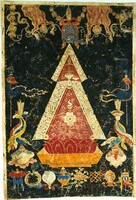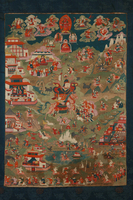Warrior Appearance & Three Moods
 Warrior Appearance is unique because it is based on Tibetan culture and not Indian cultural iconography. Warrior Appearance also describes both a look and a function. The appearance is that of a warrior and the function is that of an indeginous Tibetan god that has been subjugated, converted, and now employed as a Buddhist protector deity - called a Worldly Protector.
Warrior Appearance is unique because it is based on Tibetan culture and not Indian cultural iconography. Warrior Appearance also describes both a look and a function. The appearance is that of a warrior and the function is that of an indeginous Tibetan god that has been subjugated, converted, and now employed as a Buddhist protector deity - called a Worldly Protector.
Warrior Appearance is distinct because nothing else in Tantric iconography really looks the same. A warrior is characterized as a male figure wearing a helmet, battle armor, boots and riding a horse. The warrior can hold a range of objects/attributes such as a riding whip, sword or spear. The warrior appearance is what defines the iconographic type, however the facial expressions can range from peaceful, semi-peaceful/wrathful, all the way to extremely wrathful. For this reason it is possible to confuse Warrior Appearance for Wrathful Deity Appearance. It is the over-all visual form of the warrior that is important, not the specific facial expressions. Always notice first the horse, the battle helmet, the body armor and the felt boots.
















